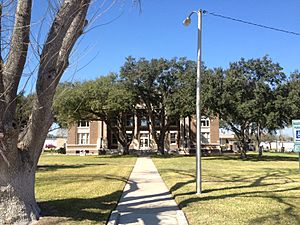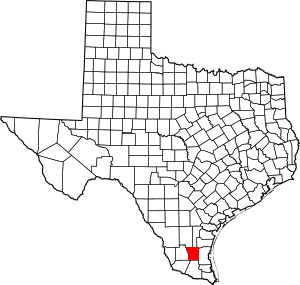Brooks County, Texas facts for kids
Quick facts for kids
Brooks County
|
|
|---|---|

The Brooks County Courthouse in Falfurrias
|
|

Location within the U.S. state of Texas
|
|
 Texas's location within the U.S. |
|
| Country | |
| State | |
| Founded | 1911 |
| Named for | James Brooks |
| Seat | Falfurrias |
| Largest city | Falfurrias |
| Area | |
| • Total | 944 sq mi (2,440 km2) |
| • Land | 943 sq mi (2,440 km2) |
| • Water | 0.3 sq mi (0.8 km2) 0.03%% |
| Population
(2020)
|
|
| • Total | 7,076 |
| • Density | 7.5/sq mi (2.9/km2) |
| Time zone | UTC−6 (Central) |
| • Summer (DST) | UTC−5 (CDT) |
| Congressional district | 15th |
Brooks County is a county in Texas, United States, and Falfurrias is its county seat. Its population was 7,076, approximately 88% Latino per the 2020 census. It is one of Texas's poorest counties.
The county is named for James Abijah Brooks, one of the “Four Captains” who modernized the Texas Rangers. He retired to Falfurrias, served two terms as state representative, lobbied successfully for the county's creation, and served thirty years as county judge.
Brooks County has several large ranches, including Mariposa Ranch and the King Ranch, both in the east. The county's largest employer is the Falfurrias Border Patrol interior checkpoint on US 281, built in 1994 outside the city limits and significantly enlarged in 2019.
Contents
"Death Valley" for Migrants
Brooks County is "the nation's busiest corridor for illegal immigration;" and a tracking camera records up to 150 people going through one piece of property nightly. More illegal migrants die in Brooks County than in any other county in America. Although it is about 80 miles (130 km) north of the border, it is on a main route headed toward San Antonio and Dallas from Mexico. The documentary Missing in Brooks County called the county the "epicenter" of America's immigration problem. It was called a "Death Valley" for migrants in 2014.
Many migrants attempt to bypass the Falfurrias United States Border Patrol interior checkpoint by hiking some 35 miles (56 km) around it through the open, dry terrain local ranchers call "the killing fields". The terrain is flat, sandy, and hard to walk on. The lack of landmarks can be disorienting, causing some migrants to walk in circles. Summer, with bright sun and high temperatures regularly exceeding 100 °F (38 °C), can lead to dehydration, sunstroke, and death.
Migrants in distress call 911, and there typically are "a few dozen cellphone calls a day". Between 2016 and 2018, there were 722 calls leading to Border Patrol rescues, usually resulting in arrest or deportation. The Border Patrol apprehends between 60 and 70 undocumented immigrants daily.
The illegal immigration issue is a significant challenge for Brooks County. Migrants bypassing the Border Patrol checkpoint sometimes damage property, tear down fences, steal, or threaten residents of the ranches through which they trespass. Residents resent the reputation the Border Patrol checkpoint and migrant deaths have given their county. Most importantly, the cost of addressing these issues has overwhelmed county resources, and the county has been unsuccessful in getting additional federal help for the local impact of a significant national issue.
The drain on local services is significant. The Border Patrol does not answer 911 calls or recover or bury dead bodies, so that falls on the county. The Brooks County Sheriff's Department, which once had 12 deputies, now has two, who work 48 hour weeks in aging vehicles with no health insurance. The Ed Rachal Memorial Library, Brooks County's only public library, is only open one day a week as of 2021.
In contrast, the Border Patrol has in its Brooks County facility, the largest border checkpoint in the country, modern equipment, dozens of 4-wheel drive trucks with infrared night-vision capabilities, a car wash, a helicopter, a blimp, a canine team, and 300 agents.
Measures to help the illegal migrants
- South Texas Human Rights, based in Brooks County, operates a hotline to answer calls about missing persons.
- Humanitarian groups have set up water stations and emergency beacons on some Brooks County ranches. Doing so is illegal, and the Border Patrol sometimes arrests offenders, but jurors in Arizona refused to convict a defendant tried for the same crime. Consequently, not all ranchers allow the water stations on their property.
- The water stations and signs in the fields have their geographical coordinates, so migrants calling for help can tell rescuers where they are.
- Due to property damage, some ranchers have stopped using fencing or placed ladders so the migrants can climb over the fences without damaging them. One rancher, however, electrified his fencing with a 220-volt electric line.
- Forrest Wilder, editor of the Texas Observer, has called for the Farfurrias Border Patrol Station to be moved to a less dangerous location.
Measures against the migrants
- Fourteen water stations were stolen in 2016.
- The South Texans' Property Rights Association, with over 600 members, tracks which landowners permit water stations and which do not.
- Texas Border Volunteers, a paramilitary group, apprehends and turns illegal migrants over to the Border Patrol. A co-founder is veterinarian Michael Vickers, who was in Missing in Brooks County.
Geography
Brooks County's total area is 943.3 sq mi (2,443 km2), with only 0.3 sq mi (0.78 km2) (0.03%) covered by water per the U.S. Census Bureau.
Major highways
Adjacent counties
- Jim Wells County (north)
- Kleberg County (northeast)
- Kenedy County (east)
- Hidalgo County (south)
- Starr County (southwest)
- Jim Hogg County (west)
- Duval County (northwest)
Demographics
| Historical population | |||
|---|---|---|---|
| Census | Pop. | %± | |
| 1920 | 4,560 | — | |
| 1930 | 5,901 | 29.4% | |
| 1940 | 6,362 | 7.8% | |
| 1950 | 9,195 | 44.5% | |
| 1960 | 8,609 | −6.4% | |
| 1970 | 8,005 | −7.0% | |
| 1980 | 8,428 | 5.3% | |
| 1990 | 8,204 | −2.7% | |
| 2000 | 7,976 | −2.8% | |
| 2010 | 7,223 | −9.4% | |
| 2020 | 7,076 | −2.0% | |
| U.S. Decennial Census 1850–2010 2010–2020 |
|||
| Race / Ethnicity (NH = Non-Hispanic) | Pop 2000 | Pop 2010 | Pop 2020 | % 2000 | % 2010 | % 2020 |
|---|---|---|---|---|---|---|
| White alone (NH) | 633 | 573 | 724 | 7.94% | 7.93% | 10.23% |
| Black or African American alone (NH) | 5 | 19 | 8 | 0.06% | 0.26% | 0.11% |
| Native American or Alaska Native alone (NH) | 7 | 10 | 9 | 0.09% | 0.14% | 0.13% |
| Asian alone (NH) | 7 | 18 | 29 | 0.09% | 0.25% | 0.41% |
| Pacific Islander alone (NH) | 6 | 0 | 0 | 0.08% | 0.00% | 0.00% |
| Other race alone (NH) | 3 | 4 | 12 | 0.04% | 0.06% | 0.17% |
| Mixed race or Multiracial (any race) (NH) | 11 | 9 | 52 | 0.14% | 0.12% | 0.73% |
| Hispanic or Latino | 7,304 | 6,590 | 6,242 | 91.57% | 91.24% | 88.21% |
| Total | 7,976 | 7,223 | 7,076 | 100.00% | 100.00% | 100.00% |
As of the 2020 United States census, there were 7,076 people, 2,475 households, and 1,419 families residing in the county. As of the 2010 United States Census, 7,223 people were living in the county; 89.6% were White, 0.5% African American, 0.3% Native American, 0.3% Asian, 7.9% of some other race, and 1.4% of two or more races. About 91.2% were Hispanic or Latino (of any race).
As of the census of 2000, 7,976 people, 2,711 households, and 2,079 families were residing in the county. The population density was 8 inhabitants per square mile (3.1/km2). The 3,203 housing units averaged 3/sq mi (1.2/km2). The racial makeup of the county was 75.84% White, 0.19% African American, 0.46% Native American, 0.09% Asian, 0.08% Pacific Islander, 21.58% from other races, and 1.77% from two or more races. About 91.57% of the population was Hispanic or Latino of any race.
Of the 2,711 households, 38.90% had children under the age of 18 living with them, 52.20% were married couples living together, 19.10% had a female householder with no husband present, and 23.30% were not families. About 21.40% of all households were made up of individuals, and 11.30% had someone living alone who was 65 years of age or older. The average household size was 2.92, and the average family size was 3.38.
In the county, the age distribution was 31.60% under the age of 18, 8.90% from 18 to 24, 23.40% from 25 to 44, 21.70% from 45 to 64, and 14.40% who were 65 years of age or older. The median age was 34 years. For every 100 females there were 94.20 males. For every 100 females age 18 and over, there were 89.90 males.
The median income for a household in the county was $18,622, and for a family was $22,473. Males had a median income of $23,051 versus $16,103 for females. The per capita income for the county was $10,234. About 36.90% of families and 40.20% of the population were below the poverty line, including 51.70% of those under age 18 and 30.40% of those age 65 or over.
Communities
City
- Falfurrias (county seat)
Census-designated places
Unincorporated community
Education
Brooks County Independent School District is the local K-12 school district.
Coastal Bend College (formerly Bee County College) is the county's designated community college.
Movie
- Missing in Brooks County is a feature-length documentary that examines the deaths in Brooks County of migrants avoiding the U.S. Border Patrol checkpoint near Falfurrias. The film has won numerous movie festival awards. As of November 2021, RottenTomatoes has given it a 100% rating. The movie tells the story of the county's plight with migrants, including the severe budget implications of the large, unreimbursed expense for recovering and burying migrants who died from dehydration or exposure. It was released for streaming November 2, 2021, and has been shown in selected theaters. It was shown on PBS's Independent Lens series in January 2022.
See also
 In Spanish: Condado de Brooks (Texas) para niños
In Spanish: Condado de Brooks (Texas) para niños

